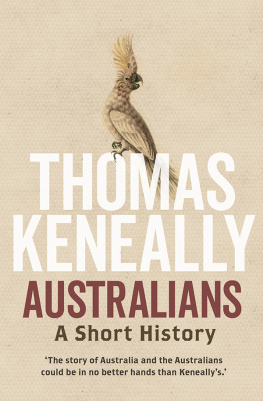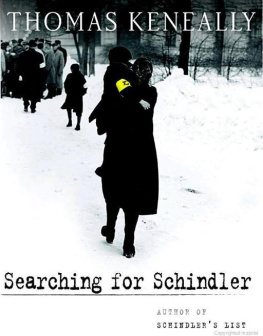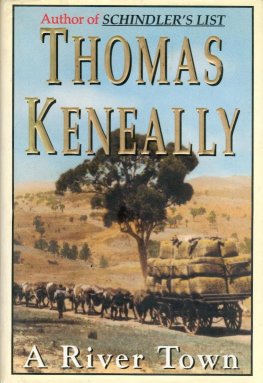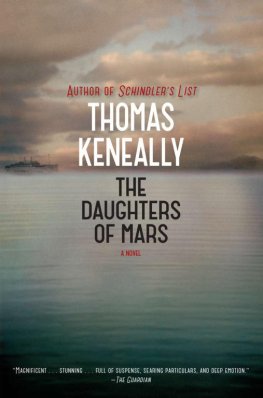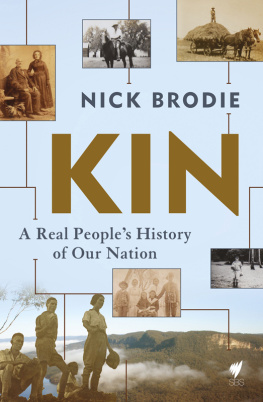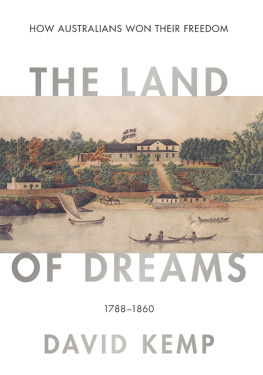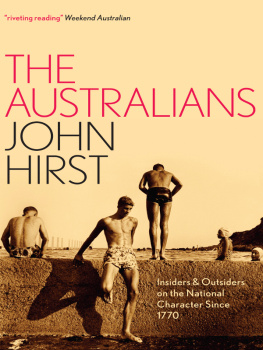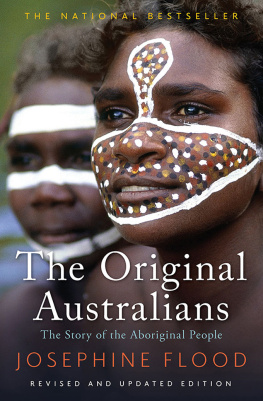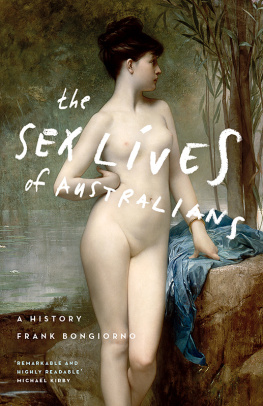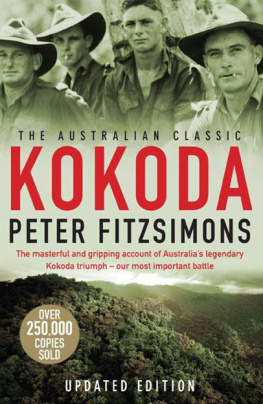To Gus, Clementine, Alex and Rory. Advance Australians Fair!
Pages : lines from William Street, Five Bells, An Inscription for Dog River and Beach Burial, by Kenneth Slessor from Selected Poems, reproduced with permission of HarperCollins.
This condensed version of Australians volumes 1, 2, and 3 published in 2016
Copyright Thomas Keneally 2016
All rights reserved. No part of this book may be reproduced or transmitted in any form or by any means, electronic or mechanical, including photocopying, recording or by any information storage and retrieval system, without prior permission in writing from the publisher. The Australian Copyright Act 1968 (the Act) allows a maximum of one chapter or 10 per cent of this book, whichever is the greater, to be photocopied by any educational institution for its educational purposes provided that the educational institution (or body that administers it) has given a remuneration notice to the Copyright Agency (Australia) under the Act.
Allen & Unwin
83 Alexander Street
Crows Nest NSW 2065
Australia
Phone:(61 2) 8425 0100
Email:
Web:www.allenandunwin.com
Cataloguing-in-Publication details are available from the National Library of Australia
www.trove.nla.gov.au
ISBN 9781760292430
eISBN 9781952535383
Jacket design: Lisa White
Jacket image: Sarah Stone (1760-1844), Crested Cockatoo, created 1790, National Library of Australia
CONTENTS


GENESIS
Once there was the All-Sea. Its brew of water and minerals and biology covered the planet. Then the first stones, sediments and bacteria of the great landmass Pangaea broke the surface of the encompassing ocean. They can still be found, these first gestures of ground, the original Mother Earth, in the Pilbara region of Western Australia.
At Taronga Zoo in Sydney there is a globe, at child height, showing Pangaea, the great agglomerated landmass, which remained one huge slab of earth for so long and began to break apart only about 140 million years ago. Pangaea is shown at the zoo in cut sections. A child can move the solid shapes which once made up the enormous single earth-mass on grooves, to create Laurasia in the north and Gondwana, the great southern super-continent. Then, further grooves on the surface enable the child to separate Gondwana into India, Africa, South America, Antarctica and Australia, and slide them to their present locations on the globe. The separation of Australia from the rest of Gondwana began 45 million years ago.
It was not all quite as clean as the zoo game indicates. The exotic separating fragment included a version of Australia, New Guinea and Tasmania in the one gigantic landmass, named Sahul by paleontologists. It was all far to the south of where it is now. Over the next fifteen million years, Sahul edged northwards, striving, but not fully managing till three million years ago, to separate itself broadly from the Antarctic and assume a position in the primeval Pacific.
To add to the complicated picture, at various stages Sahul shrank and then expanded again. It was fifteen million years ago, for instance, that Tasmania first became an island, but then, dependent on sea levels, Sahul would regularly take it back into its mass again. The last time Tasmania separated was only 11 000 years ago, when Homo sapiens was already occupying the region, at the end of the Great Ice Age.
Modern dating methods show that the arrival of the first Australians occurred at least 60 000 years Before the Present (BP). These people first crossed from the prehistoric south-east Asian district named Wallacea between 60 000 to 18 000 BP, when the Arafura Sea was an extensive plain, when sea levels were 30 metres below where they are now, and there was a solid land bridge some 1600 kilometres wide between Australia and New Guinea, then joined within Sahul. Sahuls north-western coast received only small numbers from the islands of Wallacea, possibly as few as fifty to one hundred people over a decade. They may have come by log or canoe; they may even have waded to Sahul at low tide.
Descendants of these first comers still live by the hundreds of thousands in Australia, and the picture of how they lived and what they did with the continent has been revised again and again in recent times. In the early 1960s the proposal that Aboriginal people had lived in Australia for 13 000 years was thought fanciful. But carbon dating showed campfires and tools to be at least 30 000 years old, and these days experts use luminescence dating to claim that campfires and firestick burning date from more than 100 000 years ago. Almost at once as this claim was made, in 1996, at Jinmium in the Northern Territory, Australian scientists dated stone tools as 130 000 years old. If they are right, the original Australians are the oldest race on the planet.
We must try to imagine the earth as it was then, a country of flamingos and dangerous giant carnivorous kangaroos now known as Propelopus, of Palorchestes, the bull-sized mammal whose long snout, giraffe-like tongue and massive claws may have inspired Aboriginal tales of a swamp-dwelling, man-eating monster often called the Bunyip. The marsupial lion called Thylacoleo carnifex ranged the savannahs, and Megalania prisca, a giant lizard, made excellent eating at feasts.
These early Australians believed their ancestral beings had made the visible earth and its resources, and expected the cleaning up and fertilisation done by the firestick. A number of Australian species of tree welcomed firethe banksia, the melaleuca, the casuarina, eucalyptusand fire fertilised various food plants: bracken, cycads, daisy yams and grasses. The firestick, in itself and as a hunting device, may have speeded the extinction of the giant marsupial kangaroo, the marsupial lion, the giant sloth, and other species now vanished.
DINNER AT CUDDIE SPRINGS
At Cuddie Springs, a lake bed near the north-western New South Wales town of Brewarrina, scientists have found the remains of a meal eaten over 30 000 years ago, when a spring-fed lake brimmed there and was a centre of human and animal existence. Here, in a layer of soil dated between 30 000 and 35 000 years in age, bones of Australian extinct mega-beasts have been found amongst blood-stained stone tools, charcoal and other remains of campfires. The analysis of the tools showed blood similar to that of the giant wombat-like Diprotodon. Also at the site were found wet-milled grass and grindstones or querns, the oldest examples of such implements found anywhere. Aboriginal women thirty millennia past had a milling method which was previously thought to have begun in the Middle East only 5000 years ago. Thus the triumph of the hunters lies over the bones of this long dead bump-nosed giant, as the triumph of the female millers of seed is evoked by the sandstone grinding basin.
For tens of millennia before the name Australia was applied to it, there was a clan-by-clan, ceremonial-group by ceremonial-group map of the country. In Central Australias desert, the Walpiri people used the term jukurrpa, Dreaming, to represent the spiritual and visible earth as left by the ancestors, and other language groups used similar terms. The Dreaming is seen as something eternal by many, but as one commentator says, it is a fulcrum by which the changing universe can be interpretedthe falling or rise of water levels, flood or drought, glacial steppes or deserts, the ascent or decline of species, the characteristics of animals. Another scholar is particularly worth quoting: The Dreaming binds people, flora, fauna and natural phenomena into one enormous inter-functioning world.

